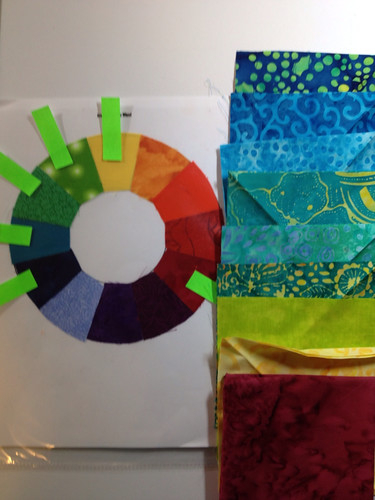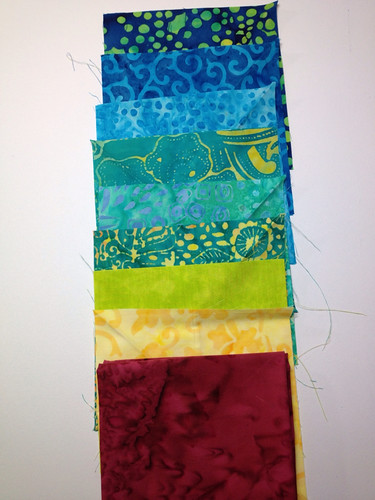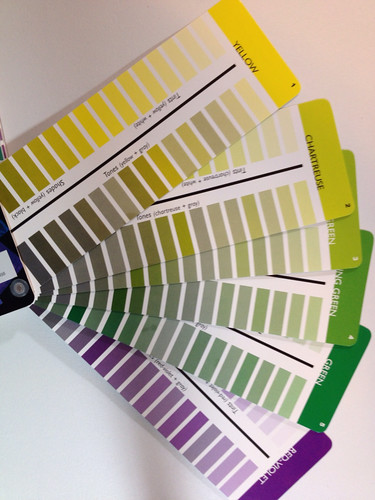We've done it! We've made our way through all the color harmonies presented in Color Magic for Quilters. By the way, this blog series in no way replaces you buying the book. I've only looked at the color harmonies. The book presents a wealth of other information, "workshop" exercises, tons of examples, and several patterns that will help you explore the harmonies in greater depth. This book is a fantastic reference--several women in my guild swear by it and I've really enjoyed my practice of working my way through each color harmony. Not only do I feel like I've broadened my color horizons, but I also know my stash a whole lot better. I'll be using this book as a reference forever after.
So put Color Magic for Quilters on your holiday gift wish list!
With no further adieu, onto the last two color harmonies.
Your first thought might be, of course, scrap quilts. And yep, those are a great example of this color harmony. Some well-known quilters have said that the more colors you use in a quilt, the better they all work together. There is still some art to doing this well, though--you will want to consider having a place for the eye to rest and so forth. But as usual, it all depends on what effect you want to achieve in your quilt. Maybe you don't want anyone's eyes to rest anywhere!
So here are a bunch of fat quarters I've matched up to various points on the color wheel. You'll note, of course, that several of the fat quarters are multi-colored. That, of course, works well in a color harmony that uses everything! Additionally, those kinds of fabrics will help everything play nicely together.
Here are the same fabrics re-arranged.
What do you think? Would you make a quilt like this?
I can see it.
Another way to approach this--and the way most of us are probably accustomed to--is to find a multi-colored focus fabric and then work off that, but pull several more of the colors off the focus fabric than we might usually. So here I have a multi-colored focus fabric that manages to hit almost every color on the color wheel (although sorry--I covered up some of them with my fat quarters). Then I found fat quarters that picked up a lot of the different colors. This is clearly an example of the multi-colored color harmony. Obviously quite workable.
Once again, the Ives Color Wheel (a.k.a. 24-Point, or the one used in Joen Wolfrom's 3-in-1 Color Tool) was intimidating to my stash. They cowered in fear. I just don't have enough fabrics to really work with the whole 24-pointer on this one.
Of course, this color harmony doesn't mean you have to use every color, just a lot of them. I simply moved on. I have other things I want to accomplish again!
I didn't bother with the usual color wheel pictures on this one because, well, you get it. But it did give me a chance to mess with a fabric I just bought during the Black Friday weekend online fabric sales. I got the main focus fabric in this picture from Fat Quarter Shop on super-duper sale. I ordered two yards but they only had a yard and a half (plus a few inches) so I took whatever they had left. It's a wonderful, vibrant, chaotic fabric that I have no idea yet what I'll do with but I can't wait to figure it out! Serious love fest with this fabric going on!
Anyway, I pulled a bunch of greens to make that the main color, but it plays up against all the riot of color in the main fabric.
Yep, this would definitely work.
So put Color Magic for Quilters on your holiday gift wish list!
With no further adieu, onto the last two color harmonies.
Throw 'Em All in There
For this color harmony, you just use 'em all. Or, at least, some significant quantity of the colors on the color wheel.Your first thought might be, of course, scrap quilts. And yep, those are a great example of this color harmony. Some well-known quilters have said that the more colors you use in a quilt, the better they all work together. There is still some art to doing this well, though--you will want to consider having a place for the eye to rest and so forth. But as usual, it all depends on what effect you want to achieve in your quilt. Maybe you don't want anyone's eyes to rest anywhere!
So here are a bunch of fat quarters I've matched up to various points on the color wheel. You'll note, of course, that several of the fat quarters are multi-colored. That, of course, works well in a color harmony that uses everything! Additionally, those kinds of fabrics will help everything play nicely together.
Here are the same fabrics re-arranged.
What do you think? Would you make a quilt like this?
I can see it.
Another way to approach this--and the way most of us are probably accustomed to--is to find a multi-colored focus fabric and then work off that, but pull several more of the colors off the focus fabric than we might usually. So here I have a multi-colored focus fabric that manages to hit almost every color on the color wheel (although sorry--I covered up some of them with my fat quarters). Then I found fat quarters that picked up a lot of the different colors. This is clearly an example of the multi-colored color harmony. Obviously quite workable.
Once again, the Ives Color Wheel (a.k.a. 24-Point, or the one used in Joen Wolfrom's 3-in-1 Color Tool) was intimidating to my stash. They cowered in fear. I just don't have enough fabrics to really work with the whole 24-pointer on this one.
Of course, this color harmony doesn't mean you have to use every color, just a lot of them. I simply moved on. I have other things I want to accomplish again!
Throw 'Em All in There, But Have One Stand Out
This is simply a twist on the one above. You're still using a boatload of colors, but you're using a bunch of one color to make it stand out. This one is, more simply speaking, multiple colors with one main color.I didn't bother with the usual color wheel pictures on this one because, well, you get it. But it did give me a chance to mess with a fabric I just bought during the Black Friday weekend online fabric sales. I got the main focus fabric in this picture from Fat Quarter Shop on super-duper sale. I ordered two yards but they only had a yard and a half (plus a few inches) so I took whatever they had left. It's a wonderful, vibrant, chaotic fabric that I have no idea yet what I'll do with but I can't wait to figure it out! Serious love fest with this fabric going on!
Anyway, I pulled a bunch of greens to make that the main color, but it plays up against all the riot of color in the main fabric.
Yep, this would definitely work.



